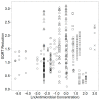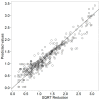Effects of Essential Oils on Escherichia coli Inactivation in Cheese as Described by Meta-Regression Modelling
- PMID: 32498276
- PMCID: PMC7353537
- DOI: 10.3390/foods9060716
Effects of Essential Oils on Escherichia coli Inactivation in Cheese as Described by Meta-Regression Modelling
Abstract
The growing intention to replace chemical food preservatives with plant-based antimicrobials that pose lower risks to human health has produced numerous studies describing the bactericidal properties of biopreservatives such as essential oils (EOs) in a variety of products, including cheese. This study aimed to perform a meta-analysis of literature data that could summarize the inactivation of Escherichia coli in cheese achieved by added EOs; and compare its inhibitory effectiveness by application method, antimicrobial concentration, and specific antimicrobials. After a systematic review, 362 observations on log reduction data and study characteristics were extracted from 16 studies. The meta-regression model suggested that pathogenic E. coli is more resistant to EO action than the non-pathogenic type (p < 0.0001), although in both cases the higher the EO dose, the greater the mean log reduction achieved (p < 0.0001). It also showed that, among the factual application methods, EOs' incorporation in films render a steadier inactivation (p < 0.0001) than when directly applied to milk or smeared on cheese surface. Lemon balm, sage, shallot, and anise EOs showed the best inhibitory outcomes against the pathogen. The model also revealed the inadequacy of inoculating antimicrobials in cheese purposely grated for performing challenge studies, as this non-realistic application overestimates (p < 0.0001) the inhibitory effects of EOs.
Keywords: antimicrobials; biopreservation; dairy; meta-analysis; mixed-effects model.
Conflict of interest statement
The authors declare no conflict of interest.
Figures




Similar articles
-
The antimicrobial efficacy of plant essential oil combinations and interactions with food ingredients.Int J Food Microbiol. 2008 May 10;124(1):91-7. doi: 10.1016/j.ijfoodmicro.2008.02.028. Epub 2008 Mar 4. Int J Food Microbiol. 2008. PMID: 18378032
-
Chemical Profile, Antibacterial and Antioxidant Activity of Algerian Citrus Essential Oils and Their Application in Sardina pilchardus.Foods. 2015 Jun 5;4(2):208-228. doi: 10.3390/foods4020208. Foods. 2015. PMID: 28231199 Free PMC article.
-
Antimicrobial Activity of Essential Oils Against Staphylococcus aureus in Fresh Sheep Cheese.Ital J Food Saf. 2014 Oct 28;3(3):1696. doi: 10.4081/ijfs.2014.1696. eCollection 2014 Aug 28. Ital J Food Saf. 2014. PMID: 27800351 Free PMC article.
-
A systematic review and meta-analysis of the use of plant essential oils and extracts in the development of antimicrobial edible films for dairy application.Vet Res Forum. 2023;14(4):179-194. doi: 10.30466/vrf.2022.1986122.3730. Epub 2023 Apr 15. Vet Res Forum. 2023. PMID: 37181858 Free PMC article. Review.
-
Application of edible coating with essential oil in food preservation.Crit Rev Food Sci Nutr. 2019;59(15):2467-2480. doi: 10.1080/10408398.2018.1456402. Epub 2018 Dec 30. Crit Rev Food Sci Nutr. 2019. PMID: 29580066 Review.
Cited by
-
Therapeutic Uses and Pharmacological Properties of Shallot (Allium ascalonicum): A Systematic Review.Front Nutr. 2022 Jul 28;9:903686. doi: 10.3389/fnut.2022.903686. eCollection 2022. Front Nutr. 2022. PMID: 35983491 Free PMC article. Review.
-
Essential Oils from Indigenous Iranian Plants: A Natural Weapon vs. Multidrug-Resistant Escherichia coli.Microorganisms. 2022 Jan 5;10(1):109. doi: 10.3390/microorganisms10010109. Microorganisms. 2022. PMID: 35056560 Free PMC article.
-
Chemical Profile and Bioactivities of Extracts from Edible Plants Readily Available in Portugal.Foods. 2021 Mar 22;10(3):673. doi: 10.3390/foods10030673. Foods. 2021. PMID: 33809865 Free PMC article.
References
-
- Kousta M., Mataragas M., Skandamis P., Drosinos E.H. Prevalence and sources of cheese contamination with pathogens at farm and processing levels. Food Control. 2010;21:805–815. doi: 10.1016/j.foodcont.2009.11.015. - DOI
-
- Gonzales-Barron U., Gonçalves-Tenório A., Rodrigues V., Cadavez V. Foodborne pathogens in raw milk and cheese of sheep and goat origin: A meta-analysis approach. Curr. Opin. Food Sci. 2017;18:7–13. doi: 10.1016/j.cofs.2017.10.002. - DOI
Grants and funding
LinkOut - more resources
Full Text Sources
Molecular Biology Databases

